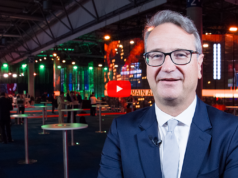Andrew Holden (Auckland, New Zealand) and Michel Reijnen (Arnhem, The Netherlands) discuss Shape Memory Polymer (Shape Memory Medical)—a porous scaffold that, according to Holden, due to a high volume of surface area, provides “a high level of stasis and thrombus […] but more importantly, as shown in pre-clinical studies, heals with collagen implantation without active inflammation”. This means it has “very interesting embolic applications in vasculature”, he adds.
“When you compare it to other embolic agents it is completely different”, states Reijnen. It offers “potentially a much more stable thrombus” when compared to regular coils and the big advantage over liquid embolics is that is “does not give a scatter on imaging afterwards”.
Holden further discusses the design benefits of the polymer as well as his first-in-human experience with the Impede embolisation plug which he says “could be delivered precisely” and “produced acute occlusion”. He also highlights how the polymer could be used for active aneurysm sac management “which is an unmet need for endovascular aneurysm repair (EVAR)” and something that the AAA-SHAPE safety trial explored.
“We are at the end of the development of EVAR devices,” claims Reijnen, who adds that “to reduce the reintervention rates and to induce sac regression, we need to start doing something else”. With this technology, “hopefully this is the next step in better performance of EVAR in the long term,” he believes.
Finally, the pair look at the ideal indications for the Shape Memory Polymer, with Holden stating that these include “medium arteries that we need to localise and occlude very focally but not get distal embolisation”. Reijnen concludes that there may be “a great role for this technology in venous pathology” which is “something that needs to be studied as well”.
This video is sponsored by Shape Memory Medical.













